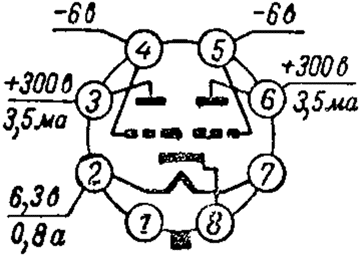(This will be a work in progress, so please be patient, as I'll be doing some in-process editing) Yellow_Light_Colorz_PDT_02

Starting with your circuit, first remove the LM334 and its current setting resistor, and replace it with a 1500 ohm, 1 watt resistor between the joined cathodes and ground, and "lift" the grounded end of the lower grid's 1K resistor. This will be used a little bit further on...
The two 0.47 uF coupling caps can be reduced to 0.1 or 0.22 uF, with no audible effect onthe low freq response.
The 1.5K rcathode resistor may be capacitor bypassed, as the audio signal isn't transferred to the lower PI section through the cathode, but rather, through its grid.
Given a B+ voltage of approximately 300VDC, (perhaps 280 VDC would be better), the two 6N7S plate resistors should be 100K, 1W. If a 6SL7 is used, these plate resistors should be 220K, 1/2 W. These values were derived from the "resistance coupled amplifier" data in the Handbook.
(The reason for choosing 6SL7 willbe explained further on, as well).
(I know, this may be getting a bit condfusing, I'll have to scan or photograph the actual schematic and post it here)
The 6V6s have to be cathode biased, the joined cathodes connect to a 240 to 270 ohm, 5 watt resistor, bypassed with a 220 to 470uf , 35V cap, to ground.
For 40 mA current, use 240-250 ohms, for 35 mA use 270 ohms. These could be independent cathode resistors and caps, just double the resistor value for each separate resistor. An LM317 or 7805 CCS could be used, but then this isn't really 1949 "old school" design philosophy) Yellow_Light_Colorz_PDT_03
Since the 6V6 section will be cathode biased, the two G1 grid resistors should be 220K, 1/2 W. Now, instead of connecting their "center" junction to ground directly (as is the usual case), connect the junction to a third 220K 1/2 W resistor, then connect this third resistor's other end to ground. Connect the junction of the three 220K resistors back to the "lower" PI grid, through the already existing 1K grid stopper resistor.
The operation of this circuit is a bit tricky to describe, I'll attempt ito do so in a subsequent posting.
The plate and UL connections to the OPT can remain as-is, the 470 ohm resistors can be 1 watt, 3W isn't really needed.
The 6V6s should see about 305VDC at the plates and SGs, so their B+ should be 310-315VDC, depending on the DCR of the OPT primary.
This is derived from the "normal" operating at 285VDC on the plates and SGs, with a fixed bias of -19V. Since the cathode bias raises the cathode voltage from 0V to +19V, just raise the 285VDC accordingly. This was given in the data sheets, with 70 mA total for the pair, 35 mA for each tube.
There should be some CRC or CLC isolation between the PI stage's B+ and the 6V6s' B+, that is why I suggested using 280 to 300 VDC for the PI's B+, the dropping series resistor value can be calculated, but I'd SWAG around 10K ohms for 30V drop, and 6.8K for 20V drop. (Assuming about 3 mA for the PI section B+)
The 6SL7 current will be lower, probably around 1.2 mA for the PI pair so the resistor should be accordingly higher.
The 6SL7 has an inherent advantage, with womewhat more gain, but it's chief advantage is that it is also available with a 12V filament, as are the 6V6 / 6V6GTs. The 12V versions are lower cost for NOS, and have the second advantage of having half the current consumption, 600 mA total for two 12V6s and one 12SL7, per channel. The 12VDC can be voltage doubled from the 6.3 VAC winding, or a 12.6VAC trannie could be used -
AC fis OK for the filaments, it doesn't have to be DC.
There is no 12V version of the 6N7 or 6N7S, as far as I know...
(to be continued...)
/ed B in NH



